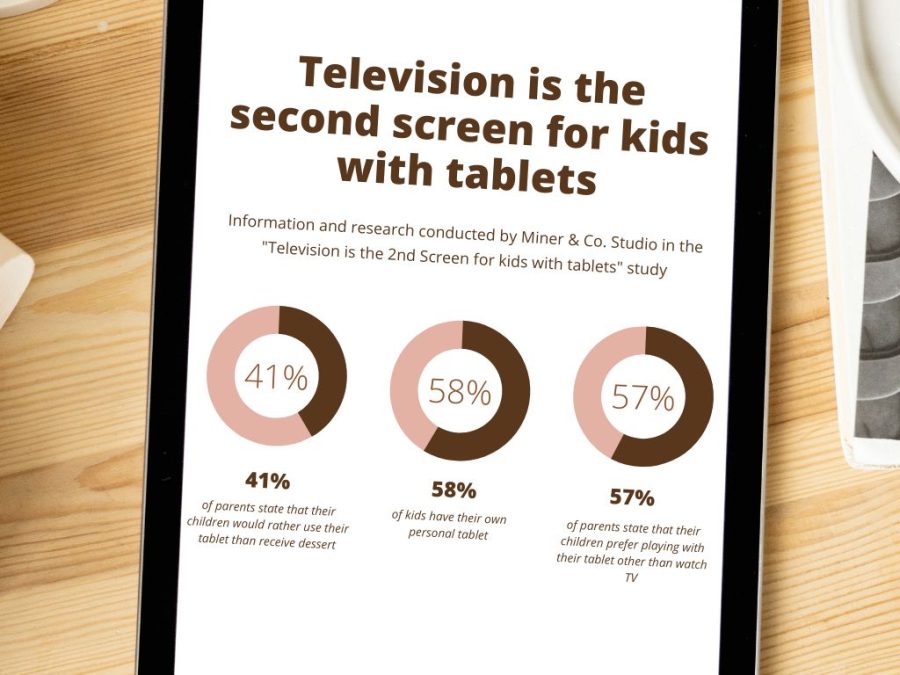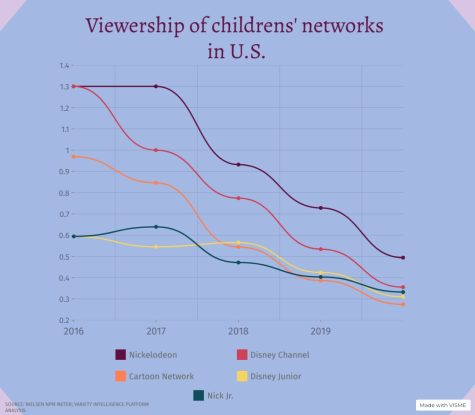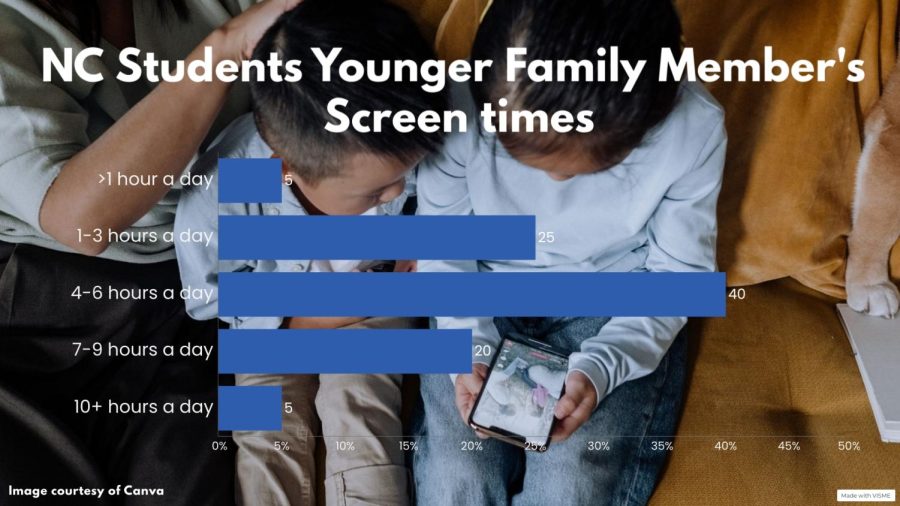Your donation will support the student journalists of North Cobb High School. Your contribution will allow us to purchase equipment and cover our annual website hosting costs.
Maturing in a mobile world: the inevitable recession of children’s television
December 2, 2022
April 30, 1939, television company Radio Corporation of America (RCA) broadcast the first publicly accessible show, the 1939 World’s Fair. In profound elation and utter disbelief, wealthy American families swarmed their new televisions as they observed the broadcast from their own homes. This exhilarating moment for Americans promptly sparked a newfound era for general media: the electronic age. The industrial age reached its final stretch, and the world of mass media started advancing with instantaneous celerity. By the 1940s and 1950s, the golden age of television solidified the TV as one of the greatest media inventions ever created.
As new technological developments became accessible to the general public, such as the remote control, affordable televisions, colored tv, flatscreen and HDTV, the television shifted into a staple interior investment. American citizens started buying multiple televisions for different rooms of their homes. By the 2000s, generations born between the 1980s and 2000s raised themselves off of television.
Children’s television became essential in American children’s lives in the 1990s. Shows such as ‘Rugrats,’ ‘Doug,’ ‘Hey Arnold,’ ‘Are You Afraid of the Dark,’ ‘Barney,’ ‘Bill Nye the Science Guy’ and several other popular ‘90s programs broadcast across ever-increasing networks rose in popularity among younger audiences. Although show developers and creators previously catered toward adults when deciding program themes, children wedged their way into becoming one of the primary consumers of shows— especially after school on weekdays.
“I loved TV shows in the ‘90s; that was usually the topic of conversation between me and my friends. I loved ‘Full House,’ ‘Family Matters,’ ‘Moesha’ and ‘Sister Sister.’ As for shows, I don’t remember anything specific other than ‘Rugrats,’ ‘Are You Afraid of the Dark?’ and anything on Nickelodeon. I remember missing certain things to be able to watch my favorite shows so I can feel cool at school when everyone talked about the latest episode; I specifically remember that my best friend in elementary school would leave me outside on her porch and forget I was visiting because she was inside watching ‘Thank God It’s Friday’ (TGIF) which was a list of popular family and teen shows that came on every Friday,” NC mother Lacy Kirkwood said.
According to a study by YouGov, “The Most Popular All-time Tv Shows,” children’s programming swept the competition off their feet. Specifically, “The Flintstones,” “Sesame Street,” “Tom and Jerry” and “The Bugs Bunny Show” took the top four slots of the most popular show rankings.
“Children’s television was a big part of my life. In the early 90s, I found myself largely watching cartoons. I was a very silly and goofy kid who got most of my humor from cartoons. I also found myself with a vivid imagination as the cartoons helped me think about the unimaginable. I got into a lot of trouble because I was doing what I saw in cartoons. I found myself talking to my friends about all the shows I watched. Every day in school, we [my friends and I] would talk about the latest episode of our favorite shows. “Teenage Mutant Ninja Turtles,” “Looney Tunes,” “Family Matters,” “Step by Step” and “Fresh Prince” were some of my favorites. Since episodes only aired once, if there was a big episode releasing they would have commercials for it, and then I would make sure I was home for those episodes,” NC father Richard Kirkwood said.
While television prevailed as one of the most revolutionary forms of entertainment and news, the rise of mobile smartphones and other smart devices, such as tablets, brought a new form of media consumption to the table.
January 9, 2007, followers of new modern technology and advancements eagerly attended the incredibly revolutionary meeting for Apple’s multimedia technology company. Presented by the late CEO of the company, Steve Jobs, Apple stoutly announced the first major modern release of a smartphone. The concepts Apple proposed included newer generations of the iPhone, the iPad, the Apple Watch and the Mac. These technological advancements knocked their phone and computer opponents out of the park, resulting in television unexpectedly becoming a prominent competitor.
Apple products offered an immense variety of applications and internet platforms that other entertainment devices did not provide. By the mid-2010s, using mobile devices authorized a convenient, quick and efficient alternative to consuming media. Smart devices permitted users to text, call, operate gaming apps and score access to streaming platforms through multiple applications. Consequently, citizens no longer needed television to watch their favorite shows and programs; they could merely take their phones out of their pockets and watch them wherever, whenever. People worldwide instantly became affixed with the concept of such a device. These advancements unfurled new possibilities for consumers to engage in new technology that allowed them to quench their utmost desire for new forms of entertainment.
According to research firm Miner & Co. Studio, an investigation of children’s media consumption found that the rise in accessible smart devices for entertainment affects children more drastically than previously expected. Entertainment companies made the assumption that the benefits of smart devices would open a way for children to access TV shows through streaming platform applications. Unfortunately, several recent studies find that children would rather engage in other content on mobile devices than watching a TV show.
“In a majority of family households with tablets and smartphones, TV is no longer the kids’ first choice for entertainment. Mobile devices offer versatility, a simple user interface and a ‘personal’ viewing experience. As such, in households where tablets and smartphones are accessible, they’ve now taken the lead with kids as the preferred way to enjoy and explore video content. TV has become the ‘second’ or even third screen for many of these kids. Parents in nearly half of these households say that when their kids misbehave, they take away their tablet and make them ‘watch TV instead’ as punishment – creating a generation of kids for whom ‘TV is punishment,’” Miner & Co. Studio said.

Another finding in the Miner & Co. Studio analysis discloses that children prefer to engage with tablets as a platform to enjoy entertainment. The accessibility of the touchscreen allowed a sense of independence from owning a personal device at a young age and the ability to re-watch videos at any time made the tablet an instantaneous sensation. These assets unquestionably present themselves as favorable to younger audiences. Parents found that these advantages very clearly outweigh television’s current lackluster benefits. Mobile devices deliver grand amounts of non-entertainment-based benefits such as immediate emergency contact, messages and access to information through the interweb. With all this in mind, why wouldn’t a parent allow their children to use a mobile device as an essential entertainment resource?
For younger generations, children as young as the age of one become consumers of mobile devices. Considering the accessibility of a handheld device, allowing children to enjoy their free time by playing with tablets and smartphones becomes an instantaneous decision caregivers establish. Children’s television, as a result, decreases in viewership.
From an outsider’s look at the children’s television recession, older siblings generally find their younger siblings at home, playing on a tablet or smartphone. While this may become an ordinary situation within the family’s home, various older counterparts of younger family members at NC recently found that children’s cable channels no longer run in their households as much as they used to.
An analysis conducted by MoffettNathanson on linear television found that citizens ages 50 and older account for up to 69% of the overall viewership on cable networks. Elderly generations feel more appeased with consuming entertainment and news through what they know best— the television. The results of their analysis reflect directly in MoffettNathanson’s study. News channels such as CBS, NBC and ABC continue to remain the most-watched channels, while networks that target children expeditiously lose their audiences.

Since 2016-2017, younger audiences no longer depend on cable networks for their at-home entertainment. The consequences of this change directly reflect on the average viewership of multiple children’s networks. A highly significant depletion, cable channel Nickelodeon, lost an average of 806K concurrent viewers within the past four years.
Declining viewership, mobile competitors and lack of proper advertising push a magnitude of children’s networks away from current success. Although this issue continues to put drawbacks on several companies, networks such as The Walt Disney Company and HBO briskly altered their platforms to continue producing shows for viewers in contemporary ways. Through the streaming platforms HBO Max and Disney+, these two companies follow up behind prominent platforms such as Hulu and Netflix. This way, children can find their favorite cable shows on outlets attainable through a tablet and phone. Although several production companies assumed this advancement would boost the number of children watching their shows on different devices and platforms, reverse effects ensued.
Competitors continue to intercept television shows from piquing the interest of younger audiences. Online video platforms YouTube, mobile games such as Roblox, interactive apps like TikTok and several alternate platforms provide mass amounts of interactive advantages and advertising catered toward children. Through targeted advertising, internet platforms can produce advertisements in more orderly means than a television network could when advertising children’s shows. Television show trailers and advertisements present themselves more prominently through television advertisement breaks. Countless children will not see these advertisements due to their inclination to use other, more intriguing leading-edge devices while leaving their household televisions in the dust.
“It’s been weird for because I love watching TV shows, but my brother would rather watch YouTube. This makes it difficult to find something that we both like and enjoy. I think this is a recurring situation because as one gets older, they begin to spend more time on their phones. For example, teenagers use their phones to communicate with their friends through social media. It’s been a few years since my younger brother watched a show off of Disney Channel, Nickelodeon, Nick Jr. or Disney Junior. Over the years, Netflix, Hulu and Disney Plus have increased in popularity because they are more convenient and do not have commercials or advertisements,” junior Megan Tate said.

NC students with younger family members also enjoy using different devices to watch videos, play games and communicate with friends online. In countless ways, students found that their younger family members do not enjoy at-home entertainment in the same way the rest of their family members do. NC students participated in a study that required them to analyze their younger family members’ screen time on mobile devices. The students answer three short questions that composed the students to check their younger family members’ mobile and television screen time and report on their findings. Results evidently found that 40% of the younger family members use their mobile devices for four to six hours daily, while 85% of the population watch less than three hours of television a day. YouTube and TikTok stood as the main apps that children use daily.
“My younger siblings, especially my six-year-old brother, are super into mobile games and YouTube rather than watching television. It makes me feel sad because they don’t get to experience the amazing shows I was able to experience as a kid. I believe that the entertainment they grew up with [older family members watching television and younger family members using mobile devices], it’s normal,” junior Ralph Philogene said.
The recession of children’s connection with television becomes inevitable as time passes. Technological advancements implement practically impossible standards for production companies to replicate through the simplicity of the standard television model. Advances in the internet and mobile devices now steer a promising way to produce and stream content to viewers. Correspondingly, declining viewership resulted in substantial economic losses in TV entertainment industries within the past four years. In response, production companies will continue to construct steps toward complete transfer from cable to streaming platforms. Noteworthy changes surface within entertainment and production companies right under viewers’ noses due to the shift of interest.
When the costs for transfers and brand reformation peak higher than expected, substantial cuts occur within these companies to save money and space for their new target audiences. The target audiences of production companies made an extensive conveyance in former years— primarily due to children’s lack of interest in TV shows. These companies no longer need to meet the needs of younger audiences. As a result, multiple platforms initiate cancellations of fan-favorite kids shows.
Mass media and entertainment company Warner Bros. Discovery recently became a prime example of the current situation of children’s television. The enterprise consists of multiple subsidiary companies, such as Cartoon Network and HBO Max. These two subsidiary companies recently faced a significant decline in employees and mass cancellations of over 30 different shows. Out of the canceled shows, more than half of the shows encompassed children-friendly shows.
As the entertainment industry traverses the evolution of technological mobility and development, the sacredness of childhood entertainment subsides. Parents of children in developmental stages unfailingly continue to move their children’s entertainment to match recent tech trends. Contemporary trends in technology include YouTube, TikTok and numerous other methods to enable kids to revel in a cheerful free time. Although these options create reasonable choices for parents to select from when introducing children to digital recreation, this simple decision can destroy a whole industry. Not only does the defacement of children’s television eliminate an industry of shows, but it can also result in the cancellation of historically noteworthy children’s shows, such as Arthur.
Newer generations of children no longer experience the same form of entertainment that older generations relished as kids. Although younger audiences can access convenient entertainment through mobile devices, the experience of appreciating scripted, animated, well-produced shows will dissolve as an experience a generous bulk of children will miss out on. While online internet services generally provide further entertainment, they simply do not come with the educational and developmental prospects children show developers unfailingly put first in their work. As children progress through the age of mobile devices, entertainment through technology will advance with them, even if the progress sparks predominantly negative consequences for children’s television industries.
